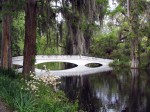
When you go to Magnolia Gardens don’t expect formal, colonial gardens like those at nearby Middleton Place. Yes, it dates back to 1676 when the original owners had a rice plantation and a garden for their own amusement but during the 19th century, the Civil War changed the nature of plantation life and the gardens were redesigned to reflect the naturalistic trends that were prevalent in England and elsewhere at that time. Magnolia Gardens has a lot to offer and the secret to its charm lies in the dark water created by the tannic acid from the roots of the native bald cypress that populate the environs. The dark waters act as mirrors for the trees, sky, and bridges that fill the landscape and Spanish moss embellish the stately live oaks. The natural vegetation is enhanced by the bright colored flowers of the introduced species, as was the style in that era. In spring, the azaleas make this a paradise but over the years the owners have introduced a variety of plants to extend the beauty of the gardens year-round.

Other features of Magnolia Gardens that have caught the fancy of gardeners are the gardens featuring camellias and magnolias, the 16th century maze, an herb garden, a Biblical garden, and a topiary garden. A visit to the plantation house and the former slave street recall the early history of the area and are well worth a visit. Many nature lovers find the diversity of plant and animal life in the Audubon Swamp Garden the highlight of their visit.
The best time to visit Magnolia Gardens is spring when the camellias and Indica azleas are in full bloom. Combine it with a visit to the other gardens near Charleston, S. C. and you have a fabulous horticultural experience.
